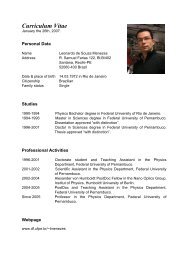Download Abstracts Book - DF-UFPE Pessoal
Download Abstracts Book - DF-UFPE Pessoal
Download Abstracts Book - DF-UFPE Pessoal
Create successful ePaper yourself
Turn your PDF publications into a flip-book with our unique Google optimized e-Paper software.
ORAL CONTRIBUTIONS<br />
Emergence of superconductivity from magnetic order in correlated<br />
electron materials<br />
M. Brian Maple<br />
Department of Physics University of California, San Diego, La Jolla, CA 92093 USA.<br />
Multinary compounds based on transition metal, rare earth, and actinide elements in<br />
which the localized d- and f-electron states are admixed with conduction electron states<br />
provide a wealth of correlated electron phenomena: e.g., metal-insulator transitions,<br />
colossal magnetoresistance, valence fluctuations, hybridization gap semiconductivity,<br />
heavy fermion behavior, non-Fermi liquid behavior, unconventional superconductivity,<br />
magnetic order, quadrupolar order, etc. The occurrence of such a wide range of<br />
correlated electron phenomena arises from a delicate interplay between competing<br />
interactions that can be tuned by variation of an external control parameter δ such as<br />
chemical composition x, pressure P, or magnetic field H, resulting in complex<br />
temperature T vs x, P, and H phase diagrams. A particularly striking phenomenon that<br />
has been observed in many correlated electron systems, including heavy fermion<br />
felectron compounds, high Tc superconducting cuprates, and, more recently, many Febased<br />
materials, is the emergence of superconductivity near the critical value δcr of a<br />
control parameter (usually, xcr or Pcr) where a magnetically ordered phase is<br />
suppressed to 0 K. For some systems, the Fermi liquid paradigm is found to be violated<br />
in the vicinity of δcr, which is manifested as weak power law and logarithmic<br />
divergences in the physical properties at low temperature (so called non-Fermi liquid<br />
behavior). The superconductivity and the non-Fermi liquid behavior may be due to<br />
quantum fluctuations of the magnetic order parameter (OP) associated with the<br />
suppression of a second order magnetic phase transition to 0 K at δcr, where δcr is<br />
referred to as a quantum critical point (QCP). The formation of the superconducting<br />
phase appears to “protect” the QCP by removing the degeneracy associated with the OP<br />
fluctuations, and the superconducting electron pairing is apparently mediated by<br />
magnetic interactions. In contrast, magnetic interactions generally have a destructive<br />
effect on conventional BCS superconductivity. Interestingly, superconductivity has<br />
recently been found to emerge from charge ordered phases such as charge density<br />
waves. In this talk, we describe selected experiments, some of which have been carried<br />
out in our laboratory, that address the interrelation between superconductivity, spin and<br />
charge order, and non-Fermi liquid behavior in novel d- and f-electron materials. The<br />
support of the US NNSA, DOE, AFOSR and NSF is gratefully acknowledged.<br />
47






